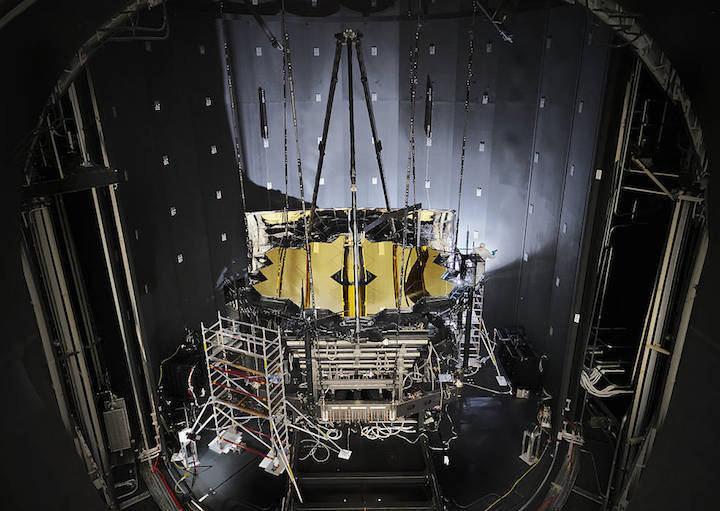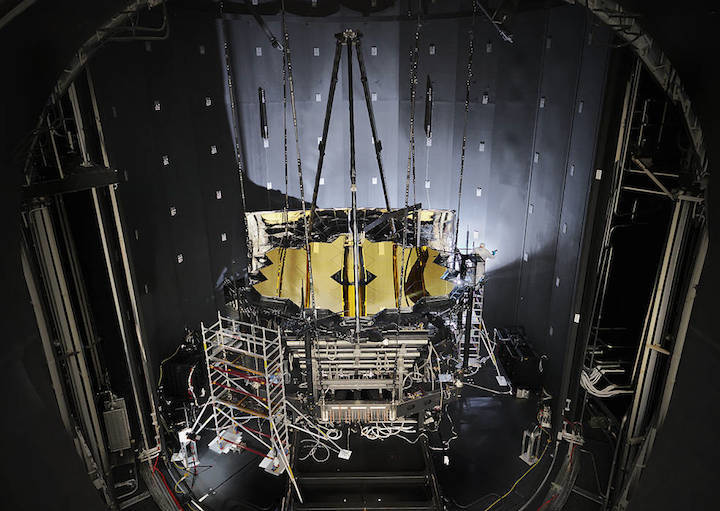
The vault-like, 40-foot diameter, 40-ton door of Chamber A at NASA’s Johnson Space Center in Houston was unsealed on November 18, signaling the end of cryogenic testing for NASA’s James Webb Space Telescope. Credit: NASA
Cryogenic thermal vacuum testing on NASA’s multi-billion dollar James Webb Space Telescope (JWST) has wrapped up at the agency’s Johnson Space Center (JSC) in Houston, TX, after undergoing 93 straight days of around-the-clock thermal vacuum testing in “Chamber A”, the largest high-vacuum, cryogenic-optical test chamber in the world, once used to test Apollo hardware and suited up astronauts.
“After 15 years of planning, chamber refurbishment, hundreds of hours of risk-reduction testing, the dedication of more than 100 individuals through more than 90 days of testing, and surviving Hurricane Harvey, the OTIS cryogenic test has been an outstanding success,” said Bill Ochs, project manager for the James Webb Space Telescope at NASA’s Goddard Space Flight Center in Greenbelt, Maryland. “The completion of the test is one of the most significant steps in the march to launching Webb.”
In order to detect the infrared light from faint and very distant objects, JWST needs to operate in an environment of 40 Kelvin (or about -387 F, -233 C), so NASA had to test it under those conditions on the ground to verify and prove its sensitive optics and instruments will perform as planned in space; there’s nobody to call for a repair one million miles away.
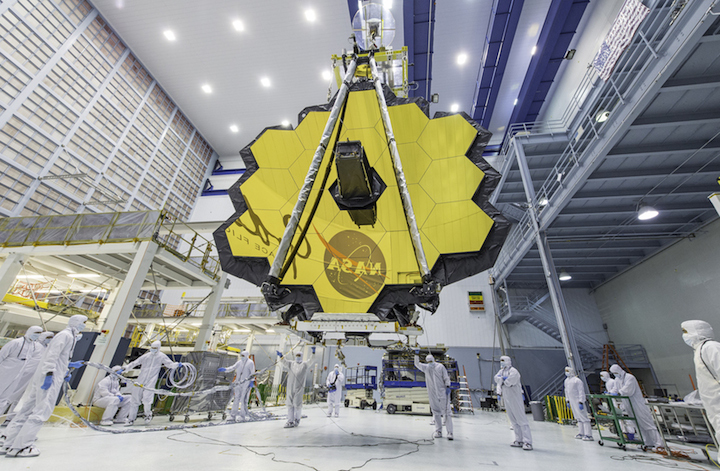
The primary mirror of JWST. Photo Credit: NASA/Desiree Stover
From NASA, “Tests included an important alignment check of Webb’s 18 primary mirror segments, to make sure all of the gold-plated, hexagonal segments acted like a single, monolithic mirror. This was the first time the telescope’s optics and its instruments were tested together, though the instruments had previously undergone cryogenic testing in a smaller chamber at Goddard. Engineers from Harris Space and Intelligence Systems worked alongside NASA personnel for the test at Johnson.”
“The Harris team integrated Webb’s 18 mirror segments at Goddard and designed, built, and helped operate the advanced ground support and optical test equipment at Johnson,” said Rob Mitrevski, vice president and general manager of intelligence, surveillance, and reconnaissance at Harris. “They were a key, enabling part of the successful Webb telescope testing team.”
More from NASA:
“Before cooling the chamber, engineers removed the air from it, which took about a week. On July 20, engineers began to bring the chamber, the telescope, and the telescope’s science instruments down to cryogenic temperatures — a process that took about 30 days. During cool down, Webb and its instruments transferred their heat to surrounding liquid nitrogen and cold gaseous helium shrouds in Chamber A. Webb remained at “cryo-stable” temperatures for about another 30 days, and on Sept. 27, the engineers began to warm the chamber back to ambient conditions (near room temperature), before pumping the air back into it and unsealing the door.”

NASA’s James Webb Space Telescope sits in front of the door to Chamber A, a giant thermal vacuum chamber located at NASA’s Johnson Space Center. The telescope will operate below an extremely cold 50 K (-223° C or -370° F) in space, so NASA simulated those conditions on the ground, ensuring the optics and instruments will perform perfectly after launch. Photo Credit: NASA / Chris Gunn
“With an integrated team from all corners of the country, we were able to create deep space in our chamber and confirm that Webb can perform flawlessly as it observes the coldest corners of the universe,” said Jonathan Homan, project manager for Webb’s cryogenic testing at Johnson. “I expect [Webb] to be successful.”
“While Webb was inside the chamber, insulated from both outside visible and infrared light, engineers monitored it using thermal sensors and specialized camera systems. The thermal sensors kept tabs on the temperature of the telescope, while the camera systems tracked the physical position of Webb to see how its components very minutely moved during the cooldown process.”
“This test team spanned nearly every engineering discipline we have on Webb,” said Lee Feinberg, optical telescope element manager for the Webb telescope at Goddard. “In every area there was incredible attention to detail and great teamwork, to make sure we understand everything that happened during the test and to make sure we can confidently say Webb will work as planned in space.”
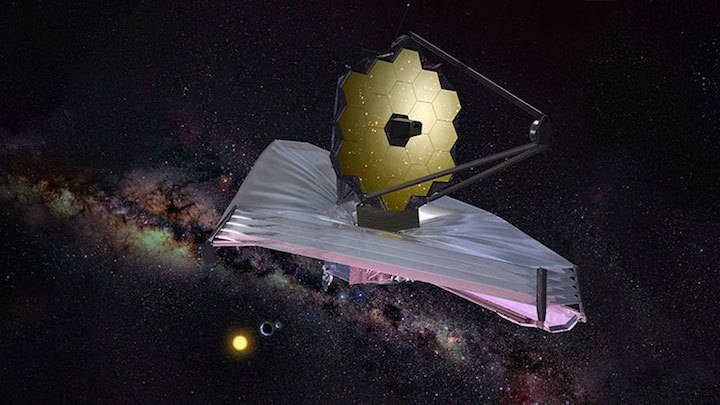
NASA’s upcoming James Webb Space Telescope will be positioned at the Earth-Sun L2 Lagrange point, 1.5 million km away from the low-Earth orbiting Hubble Space Telescope. Taking advantage of the telescopes’ relative distance, astronomers could image celestial objects in the Solar System with depth perception. Image Credit: NASA/STScI
Webb will now be removed from its test platform, rotated from vertical to horizontal, packed for shipment and carefully hoisted into a climate-controlled shipping container for transport to Northrop Grumman Aerospace in California in early 2019, where Webb’s combined science instruments and optics will be integrated with the spacecraft element, which is the combined sunshield and spacecraft bus.
The tennis-court sized sunshield is critical in preventing background heat from the Sun, Earth and Moon from interfering with the telescope’s sensitive infrared instruments; JWST simply cannot science without it. Five sunshield membrane layers, each as thin as a single human hair, will reduce the temperatures between the hot and cold sides of the JWST by an incredible 570 degrees Fahrenheit; equivalent to SPF 1 million sunblock.

“Imagine you are the telescope”, note the engineers standing where the telescope will within its protective 5-layer sunshield. Photo Credit: Northrop Grumman
Together, the pieces will form the complete James Webb Space Telescope observatory.
The fully assembled JWST will then undergo more tests during what is called “observatory-level testing”, followed by flight and deployment testing on the whole observatory before being packed and shipped to its launch site at the edge of the Amazon rainforest in French Guiana, South America, for flight atop a European Space Agency Ariane 5 rocket in Spring 2019.
Quelle: AS
---
Update: 1.12.2017
.
NASA’s James Webb Space Telescope, or Webb, emerged from Chamber A at NASA’s Johnson Space Center in Houston on Dec. 1 to prepare for its upcoming move to California.

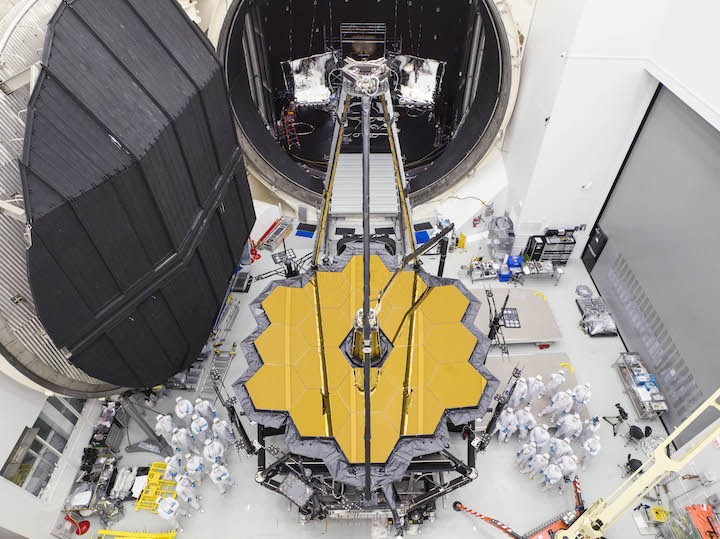
NASA’s James Webb Space Telescope emerged from Chamber A at NASA’s Johnson Space Center in Houston on Dec. 1, 2017, to prepare for its upcoming move to California.
The telescope’s combined science instruments and optical element recently completed about 100 days of cryogenic testing inside Johnson’s Chamber A, a massive thermal vacuum testing chamber at the center. Scientists and engineers at Johnson put Webb through a series of tests designed to ensure the telescope functioned as expected in an extremely cold, airless environment akin to that of space.
This move outside the chamber brings Webb one step closer to its journey to Northrop Grumman Aerospace Systems in Redondo Beach, California, where it will be integrated with its spacecraft element to form the complete James Webb Space Telescope observatory. The spacecraft element is Webb’s combined sunshield and spacecraft bus.
The James Webb Space Telescope is the world’s premier infrared space observatory of the next decade. A barrier-breaking mission for engineers and astronomers, Webb will solve mysteries of our solar system, look beyond to distant worlds around other stars, and probe the mysterious structures and origins of our universe and our place in it. Webb is an international program led by NASA with its partners, the European Space Agency (ESA), and the Canadian Space Agency (CSA).
Quelle: NASA
---
Update: 6.12.2017
.
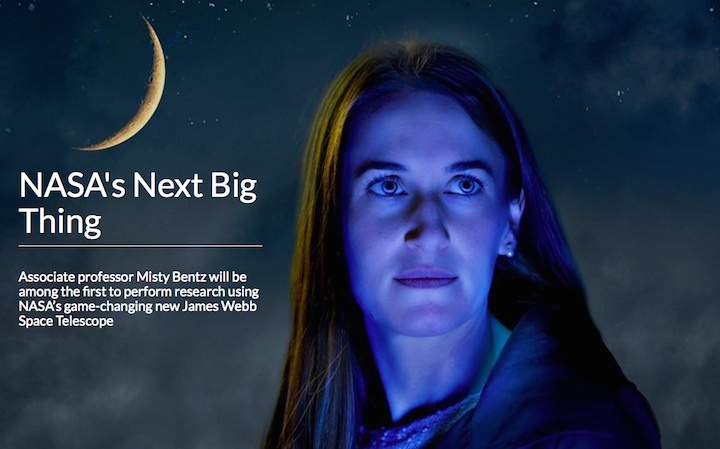
Interview by Jennifer Rainey Marquez
When it launches in 2019, the James Webb Space Telescope (JWST) will be NASA’s most powerful observatory in space — capable of peering deep into the universe. More than 100 teams of scientists competed to carry out the first research using the telescope, and recently the space agency announced it had chosen 13 proposals to study a wide range of targets. One of those inaugural teams will be led by Dr. Misty Bentz, an associate professor in Georgia State’s Department of Physics and Astronomy. We recently spoke with her about the galaxy she plans to study.
Congratulations on being among the first researchers selected to use the JWST, which some people are calling the next Hubble. How do the two telescopes compare?
It’s not exactly a replacement for Hubble. It’s a different kind of tool. Hubble can see three types of light: visible light, ultraviolet light, which is what burns your skin, and infrared light, which you can’t see but you can feel. Think of a heat lamp.
However, Hubble’s limitation is that its mirror is relatively small. The bigger the mirror, the more light it can collect and the fainter the objects it can see. The JWST’s mirror is more than seven times the size of Hubble’s mirror, so it will be able to see objects that are very faint and far away. But the JWST has a limitation as well, which is that it only works in infrared light and the red part of the visible light.
We as scientists need to figure out how to best use this new tool, and our project will very carefully test one of the specific instruments on the telescope.
What exactly will you be testing?
This particular instrument can measure spectra from many different positions. People say a picture is worth 1,000 words, but a spectrum is worth 1,000 pictures, because it provides so much information about temperatures, densities, chemical compositions, motions—all these things we want to be able to learn more about. And if we can study spectra at all these different positions, now we have a huge amount of information that can show us the physics of what’s happening in the galaxy.
We’ll be using this instrument to observe a galaxy that’s about 60 million light years away. We’re evaluating how the data from this new instrument compare to the data we can get using telescopes that we have here on the ground on Earth.
How did you choose this galaxy to study?
In the process of doing these tests, we’ll be trying to determine the mass of the supermassive black hole in the center of the galaxy. We call black holes “black” because they’re invisible, which makes them very difficult to observe — unless they’re actively feeding. When a black hole “eats” matter that material gets super-heated, which makes it glow, just like a metal rod when you stick it in a fire.
But black holes that are actively feeding are pretty rare in the universe these days. There are only about six or seven feeding black holes that are relatively close by, in terms of things in outer space. Of those, we chose this one because we have good data from the ground already, so we can directly compare our observations to what we’ve been able to observe before.

What can we learn by studying these kinds of black holes?
We’ve found that the mass of a black hole is actually related to several other characteristics of the surrounding galaxy. Which is interesting — why would you have this enormous extended galaxy that seems to reflect something about this relatively small compact thing in the middle? From what we’ve been able to tell, they actually regulate the growth of one another.
As a black hole is feeding, it’s releasing a lot of energy into the galaxy. That energy can run into gas clouds and shut down star formation. Or it can throw material out of the galaxy, which shuts down the feeding process. So it seems that galaxies and black holes have evolved together over the history of the universe.
Studying black holes may provide insight into other questions like: Why does the universe look the way it does? Why does our galaxy look the way it does today? What can that tell me about how things have changed over the last 14 billion years? And is it somehow related to why we’re here?
When will your project begin?
It will most likely be about two years from now. After launch, which is scheduled for spring 2019, the JWST will fly for a month to get a million miles out to its location. Then there will be some tests to make sure everything is turned on and working properly. It’s expected that about six months after launch is when these 13 research projects will commence.
Why do you think that yours was one of the projects chosen this first round?
I think I convincingly made the case that these are important questions to answer in order to potentially open up new areas of scientific research.
Hopefully, we’ll find that you can do all sorts of interesting work with this new instrument, and then that will inspire other people to say, “Well if that’s the case, then I have this great idea.” And, of course, I’d like to be one of those people too. But it’s important to actually do the test first.
What has it been like since you got the go-ahead from NASA?
As so many colleagues have reached out — and they’re all so excited for me — it has started to sink in that this is kind of a big deal. I’ve done a lot of proposals for the Hubble telescope before, and most of the time you are told “no.” So a real honor to get a “yes.”
Quelle: Georgia State University
---
Update: 7.12.2017
.
NASA:
Preliminary Observations on the Management of Space Telescopes
GAO-18-277T: Published: Dec 6, 2017. Publicly Released: Dec 6, 2017.

The James Webb Space Telescope Mirror
In this testimony, we note that NASA's 3 major telescope projects are all making progress in development, but also face some challenges.
For example, the James Webb Space Telescope has made progress in developing and testing its hardware and instruments, and addressing technical problems. However, the project has already been delayed by up to 60 months. Additional delays are likely given the risks associated with final integration of the telescope and the spacecraft—the next phase of the project.
Quelle: GAO
---
Update: 9.12.2017
.
RIT professor among first to use James Webb Space Telescope during its inaugural run
Jeyhan Kartaltepe is one of the leaders of the Cosmic Evolution Early Release Science Survey

The James Webb Space Telescope will give scientists a new level of detail in studies about the structure of galaxies. This side-by-side image compares the resolution of a distant galaxy imaged by the Spitzer Space Telescope in the near-infrared, left, to a simulated image from the Webb telescope.
-
Rochester Institute of Technology astrophysicist Jeyhan Kartaltepe will be one of the first scientists to use NASA’s James Webb Space Telescope soon after it launches in spring 2019. The Webb telescope is regarded by many as the powerful successor to the Hubble Space Telescope, with sensitive infrared detectors designed to peer 13.5 billion years into the universe’s history.
Kartaltepe, assistant professor in RIT’s School of Physics and Astronomy, is a leading member of the Cosmic Evolution Early Release Science (CEERS) Survey team selected as part of the James Webb Space Telescope Director’s Discretionary Early Release Science Program. It is one of 13 science teams that will use the $8 billion telescope first, conducting experiments during its initial cycle and testing the instruments’ capabilities.
The Cosmic Evolution Early Release Science Survey will use multiple instruments on the space telescope and test different observation modes. The international project consists of 105 astronomers from 10 countries, including 28 U.S. universities.
A decade in the making, the Webb telescope soon will be the most advanced and sensitive space telescope in operation. It will be positioned farther in space than the Earth-orbiting Hubble telescope and will carry a larger mirror (6.5 meters compared to Hubble’s 2.4 meters) and sensitive infrared detectors.
“The James Webb Space Telescope will be ground breaking,” Kartaltepe said. “It will detect some of the first galaxies that formed in the universe and will provide detailed information about the structures and physical conditions of galaxies over the age of the universe.”
Kartaltepe’s research focuses on how galaxies have evolved from the early universe to today. As a team leader on the survey, she will spearhead data processing efforts for one of the instruments and measure detailed properties of galaxies and their nuclei in order to investigate star formation and the growth of supermassive black holes in the early universe.
The project will “demonstrate, test and validate extragalactic surveys in the near- and mid-infrared and inform the design of future James Webb Space Telescope surveys,” Kartaltepe said. Her research group, including RIT students and postdoctoral researchers, will conduct some of the first science investigations with this data set.
The larger astronomical community will have immediate access to the resulting observations. Kartaltepe anticipates that astronomers all over the world will use data products produced by the survey team in preparation for the next cycle of observations with the new telescope.
The Space Telescope Science Institute operates NASA’s James Webb Space Telescope, which was developed in partnership with the European Space Agency and Canadian Space Agency. The telescope is named after NASA’s second administrator. James Webb led the Apollo lunar exploration program and a space-science initiative that resulted in more than 75 launches.
Quelle: Rochester Institute of Technology
---
Update: 6.01.2018
.
Media are invited to NASA’s Johnson Space Center in Houston at 2 p.m. EST Wednesday, Jan. 10, to hear about the results of recent cryogenic vacuum tests on the James Webb Space Telescope, and the next steps on the observatory's path to space.
The news conference will air live on NASA Television and the agency’s website.
Participants will be:
- Ellen Ochoa, Johnson center director and veteran NASA astronaut
- Bill Ochs, Webb telescope project manager at NASA’s Goddard Space Flight Center in Greenbelt, Maryland
- Jonathan Homan, project manager for Webb telescope Chamber A Test Team at Johnson
- Mark Voyton, Webb telescope Optical Telescope Element and Integrated Science Instrument Module (OTIS) manager at Goddard
U.S. media who would like to participate in person must call the Johnson newsroom at 281-483-5111 by 6 p.m. Tuesday, Jan. 9. Reporters who wish to participate by telephone must call Johnson's newsroom no later than 1:45 p.m. Jan. 10. Those following the briefing on social media may ask questions using the hashtag #askNASA.
Webb was tested as a complete optical system in Chamber A at Johnson, which mimics the space environment the telescope will experience during its mission. Built in 1965 to conduct thermal-vacuum testing on the Apollo command and service modules, Chamber A is the largest structure of its kind in the world and is a listed National Historic Landmark.
The James Webb Space Telescope is the world’s premier infrared space observatory of the next decade. Webb will help to solve mysteries of our solar system, look to distant worlds orbiting other stars, and probe the mysterious structures and origins of our universe and our place in it. Webb is an international program led by NASA with its partners, the ESA (European Space Agency) and the Canadian Space Agency.
Quelle: NASA
---
Update: 16.01.2018
.
The James Webb Space Telescope has emerged from the freezer
"NASA and its partners have an outstanding telescope and set of science instruments."

After spending three months at a temperature of just 20 degrees Celsius above absolute zero, the massive James Webb Space Telescope emerged from a large vacuum chamber at the end of 2017. Now, after reviewing data from testing done there, scientists have given the instrument a clean bill of health, moving it one step closer to space.
"We now have verified that NASA and its partners have an outstanding telescope and set of science instruments," said Bill Ochs, the Webb telescope project manager at NASA’s Goddard Space Flight Center in Greenbelt, Maryland. "We are marching toward launch."
Lots of tests
The $10 billion telescope underwent tests inside Chamber A at Johnson Space Center, which was built in 1965 to conduct thermal-vacuum testing on the Apollo command and service modules. Beginning in mid-July, after the telescope was cooled down to a temperature range of 20 to 40 Kelvin, engineers tested the alignment of Webb's 18 primary mirror segments to ensure they would act as a single, 6.5-meter telescope. (They did).
Later, they assessed the fine guidance system of the telescope by simulating the light of a distant star. The Webb telescope was able to detect the light, and all of the optical systems were able to process it. Then, the telescope was able to track the "star" and its movement, giving scientists confidence that the Webb instrument will work once in space.
Webb still has a ways to go before it launches. Now that project scientists know that the optic portion of the instrument can withstand the vacuum of space, and the low temperatures at the Earth-Sun L2 point it will orbit in deep space, they must perform additional testing before a probable launch next year.
Next stop, California
At the end of this month, or early in February, the telescope will move to Ellington Field in southeast Houston where it will fly aboard a C-5 aircraft to Northrop Grumman's facilities in Los Angeles. There, the optical instrument will be mated to its spacecraft and sunshield to form the complete telescope. Subsequent tests will determine that the sunshield deploys properly and that the combined instrument can withstand the vibrations produced during launch. Finally, the telescope will be flown to French Guiana for a launch aboard an Ariane 5 rocket no earlier than spring 2019.
NASA is taking all of this care with the extremely valuable Webb telescope because it will be difficult if not impossible to service due to its observing location, which is farther from Earth than the Moon. Moreover, before Webb can begin to observe light from the very first galaxies in the Universe, it must perform a complicated ballet in space.
Scientists are especially concerned about the deployment of the telescope and its sunshield, which will keep the instrument cold and allow it to detect faint, infrared signals from distant sources. More than 180 devices must work properly for the sunshield, which measures 14 meters by 21 meters, to deploy. "That is what makes us most nervous," admitted Jonathan Homan, project manager for Webb telescope test team in Houston.
Quelle: arsTechnica
---
Update: 6.02.2018
.
Combined Optics and Science Instruments of NASA’s James Webb Space Telescope Arrive at Northrop Grumman
REDONDO BEACH, Calif. – Feb. 5, 2018 – The two halves of NASA’s James Webb Space Telescope now reside at Northrop Grumman (NYSE:NOC) in Redondo Beach, Calif., where they will come together to form the complete observatory.
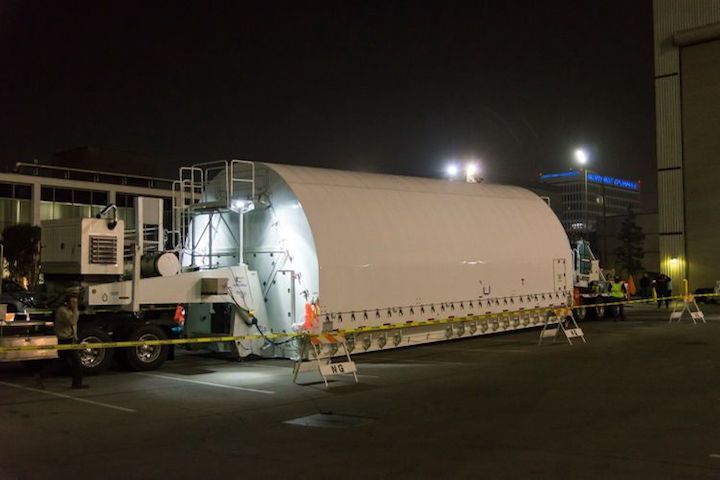
The Space Telescope Transporter for Air, Road and Sea (STTARS) container enclosed with NASA’s James Webb Space Telescope’s Optical Telescope and Integrated Science instrument module (OTIS) arriving at Northrop Grumman Redondo Beach, CA facilities on Friday, February 2.
“This is a major milestone,” said Eric Smith, program director for Webb at NASA. “With the arrival of the science payload at Northrop Grumman’s Space Park facility, we will now carefully test the observatory to ensure the work of thousands of scientists and engineers across the globe is ready for launch and will enable people to seek the first luminous objects in the universe and search for signs of habitable planets.”
The optical telescope and integrated science instrument module (OTIS) of Webb arrived at Northrop Grumman on Friday, Feb. 2. It was previously at NASA’s Johnson Space Center in Houston, where it successfully completed cryogenic testing.
In preparation for leaving Johnson, OTIS was placed inside a specially designed shipping container called the Space Telescope Transporter for Air, Road and Sea. The container was then loaded onto a U.S. military C-5 Charlie aircraft at Ellington Field Joint Reserve Base, just outside of Johnson. From there, OTIS took an overnight flight to Los Angeles International Airport (LAX).
Upon its arrival, OTIS was driven from LAX to Northrop Grumman. OTIS and the spacecraft element, which is Webb’s combined sunshield and spacecraft bus, now both call Northrop Grumman home.
“It’s exciting to have all three Webb elements – OTIS, sunshield and spacecraft bus, here at our campus,” said Scott Willoughby, vice president and program manager for Webb at Northrop Grumman. “The team is excited to begin the final stages of integration of the world’s largest space telescope.”
During the summer, OTIS will receive additional testing before being combined with the spacecraft element to form the complete James Webb Space Telescope observatory. Once the telescope is fully integrated, the entire observatory will undergo more tests during what is called observatory-level testing.
Webb is scheduled to launch from Kourou, French Guiana, in 2019.
The James Webb Space Telescope is the world’s premier space observatory of the next decade. Webb will solve mysteries of our solar system, look beyond to distant worlds around other stars, and probe the mysterious structures and origins of our universe and our place in it. Webb is an international program led by NASA with its partners, the European Space Agency and the Canadian Space Agency.
Northrop Grumman is a leading global security company providing innovative systems, products and solutions in autonomous systems, cyber, C4ISR, strike, and logistics and modernization to customers worldwide.
Quelle: Northrop Grumman Corporation
+++
Update: 7.02.2018
-
JWST optics and instruments arrive in California

A shipping container holding the optics and instruments for NASA's James Webb Space Telescope is removed from a C-5 cargo aircraft Feb. 2 for transport to a Northrop Grumman facility, where it will later be integrated with the spacecraft bus and sunshield. Credit: NASA/Chris Gunn
-
TITUSVILLE, Fla. — The optics and instruments for NASA’s James Webb Space Telescope have arrived at the California factory where they will be integrated later this year with the rest of the spacecraft for launch next year.
The Optical Telescope and Integrated Science instrument module, or OTIS, arrived at a Northrop Grumman facility in Redondo Beach, California, late Feb. 2 after being flown on a U.S. Air Force C-5 cargo plane from Ellington Field, Texas, near the Johnson Space Center.
The OTIS unit, which consists of the telescope’s optics and science instruments, recently completed a 100-day thermal vacuum test in an Apollo-era chamber at the Johnson Space Center. Those tests confirmed the performance of those key parts of the telescope at very low temperatures.
OTIS is now at the same Northrop Grumman facility where the company has been building the mission’s other key components, the spacecraft bus and a deployable sunshield the size of a tennis court, collectively known as the integrated spacecraft element. “It’s exciting to have both halves of the Webb observatory — OTIS and the integrated spacecraft element — here at our campus,” said Scott Willoughby, vice president and program manager for Webb at Northrop Grumman, in a statement. “The team will begin the final stages of integration of the world’s largest space telescope.”
The two halves, though, won’t immediately be combined. In an interview last month during a meeting of the American Astronomical Society in suburban Washington, DC, Willoughby said the bus and sunshield must first complete a series of environmental tests and well as tests of the deployment of the sunshield. He said OTIS would likely be installed on the spacecraft in August or September, after which the combined spacecraft will undergo additional environmental and deployment tests.
The combined spacecraft will be transported by ship from California to French Guiana in early 2019 for launch on an Ariane 5. That launch is planned for between March and June of 2019, although NASA has not yet set a more specific date.
NASA had earlier planned to launch JWST this October, but announced in September 2017 that the launch would be delayed to early 2019 because of issues with the spacecraft development. These problems included delays in deployment tests of the sunshield and a problem with valves in spacecraft thrusters.
Those issues, Willoughby said last month, led to a mutual decision by NASA and Northrop to delay the launch to give the team more time to complete work. “When we looked at all of that, we said that, for the work we have in front of us, we need more time.”
Quelle: SN
---
Update: 10.02.2018
.
How To Pack A Space Telescope
As complicated as it as to launch and operate a telescope in space, it's almost as complex to move a space telescope around here on Earth.
For the past 9 months or so, NASA has been testing the James Webb Space Telescopein a giant cryogenic chamber at Johnson Space Center in Houston, Texas. The $8.8 billion Webb telescope is the most powerful telescope NASA has ever built.
To say astronomers are looking forward to the launch of the Webb telescope is an understatement.
"For my own personal science I am ridiculously excited," says astrophysicist Jackie Faherty of the American Museum of Natural History. She studies space objects known as brown dwarfs, one of a wide variety of topics that the Webb telescope will provide data on.
Those topics range "from the first moments of when the universe was created, to what we're going to get to know about that are orbiting other stars," says Faherty, potentially including planets that could support life.
When the telescope launches next year, it is supposed to park in a spot a million miles from Earth and provide unprecedented glimpses of the earliest light in the universe.
But first it needed to move from Texas to California.

Engineers next to NASA's James Webb Space Telescope at NASA's Johnson Space Center in Houston.
You can't just stuff a space telescope into a box when you're ready to ship it. Every step of the process involves special equipment, special planning and special attention. The packing process, from preparing the container to loading the telescope, took four days in January. Each step in the process is done slowly, to minimize the chance of error.
"We like it to go slow and steady," says Sandra Irish, an engineer at NASA's Goddard Space Flight Center. Her job is to make sure the telescope isn't subjected to any stresses it can't handle. It was designed to operate in the essentially weightless environment of space. Here on Earth gravity is a problem.
The entire packing process happened inside a multi-story clean room built to hold the telescope and its shipping container called STTARS, the Space Telescope Transporter Air, Road and Sea. STTARS is basically a flat pallet 110 feet long with a frame on top and a bright-white domed lid.
When it was packed, the telescope weighed about eight thousand pounds; it will get heavier when the sun shield and flight electronics get added later. Folded up for shipping, the telescope was about the size of a large school bus.
Once it was packed, the telescope was trucked over to nearby Ellington Air Force Base, loaded into a specially modified military cargo plane, and flown to Los Angeles.

The cavernous hold of the U.S. military's C-5 cargo plane was designed to carry tanks. The Space Telescope Transporter for Air, Road and Sea (STTARS) used to transport the James Webb Space Telescope is so tall that it barely fits inside.
There, aerospace firm Northrop Grumman will get the telescope into its launch configuration, a process that will take months. Then it goes by ship next spring from Southern California to French Guiana, where it is scheduled to be launched on an Ariane rocket in June 2019.
Quelle: npr
---
Update: 1.03.2018
.
GAO warns JWST could face more delays and cost overruns

CAPE CANAVERAL, Fla. — NASA’s James Webb Space Telescope faces the high probability of additional delays that could cause the telescope to exceed its cost cap, the U.S. Government Accountability Office warned in a Feb. 28 report.
The report, the sixth in a series of annual assessments of the flagship astronomy mission delivered to Congress, concluded there is little schedule reserve left in in the spacecraft’s development, making delays in its launch beyond June 2019 likely.
JWST had been on track for several years for a launch in October 2018. But, in September 2017 NASA announced it was delaying the launch to between March and June 2019 after concluding spacecraft development activities were taking longer than expected.
The new launch window gave the mission an additional four months of schedule reserves. However, the GAO noted in its report that not long after announcing the new launch date, project managers learned that Northrop Grumman would need an additional three months “due to lessons learned from conducting deployment exercises of the spacecraft element and sunshield,” portions of the overall observatory the company had been working on while NASA was testing its optical system and instruments.
After taking into account “some schedule efficiencies,” the GAO said that JWST has 1.5 months of schedule reserve left. “Given the remaining integration and test work ahead,” it concluded, “we believe that additional delays to the project’s launch readiness date are likely.”
Project officials previously said issues with the spacecraft’s thrusters and the sunshield, five layers of Kapton material that will deploy to the size of a tennis court after launch to keep the telescope cold, contributed to the slip in JWST’s launch from October 2018 to the spring of 2019. Thrusters had to be removed to refurbish faulty valves, while deployment and repackaging of the sunshield took longer than expected.
“The actual harder part is not deploying it, in terms of time, but folding it back together,” Scott Willoughby, vice president and program manager for JWST at Northrop Grumman, said of the sunshield in a January interview. “Deploying took a couple weeks, but folding it takes nearly two months.”
The GAO report also noted that, during the sunshield deployment exercises, Northrop discovered several tears in the material which it attributed to “workmanship error.” Those tears can be repaired but may consume more schedule reserve. A slight change in the design of a membrane tensioning system is planned to correct a snag encountered during a test, but the report said it wasn’t known if that would also affect the overall schedule.
Northrop Grumman now has personnel working on JWST in three shifts, 24 hours a day, which the report cautioned “further limits schedule flexibility.” The company’s workforce devoted to JWST as of l

